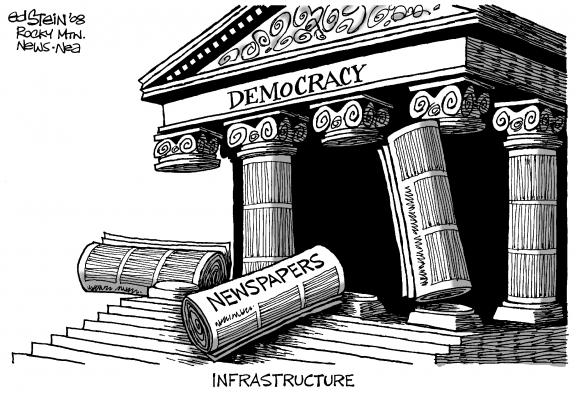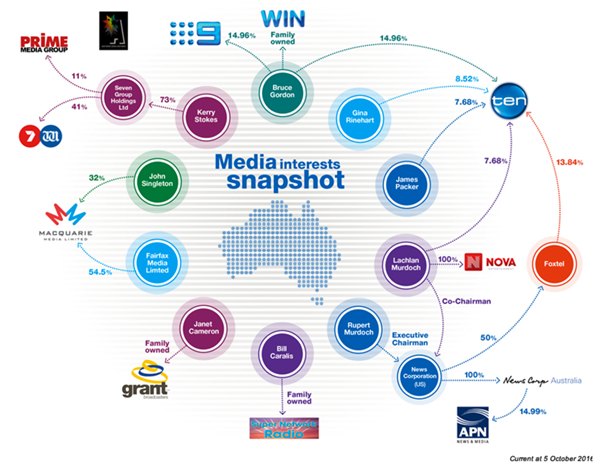The distortion of the Australian public sphere: Media ownership concentration in Australia

The following article, by Associate Professor Johan Lidberg, first appeared in Australian Quarterly (Jan-Mar 2019) and is reproduced here with the permission of the Editor-in-Chief and the author.
They say News Corp staff can feel when Rupert Murdoch is in town. The 88-year-old chairman of News Corp has achieved a mythical status in Australia and around the globe. He is the maker and breaker of prime ministers, his latest scalp that of Malcolm Turnbull. His company also embodies the societal problem with media ownership concentration.
This article will not resort to News Corp bashing, because the problem is far greater than just one company. But there are a few useful case studies emanating from News Corp that I’ll return to. The wider problem is a structural and regulatory issue where Australian politicians, from both major parties, have yet again failed to play the role of the honest broker between market forces and the public interest.
Australia is not alone in having a concentrated media market. We can see similar patterns emerging both in the US and in some parts of Europe[i]. But Australia stands out as one of the most concentrated media markets in the world and this increasing concentration has been happening for some time[ii]. There is also the question of why it also appears to be speeding up.
Background
We could program our Tardis to revisit various technological disruptions that have led to first media expansion and then concentration, eg. offset printing, the birth of radio followed by TV, but they all pale in comparison with the birth of the internet within which the world wide web (www) exists. The online/digital disruption was, and still is, immense and it caught most legacy media companies off guard.
I saw my first web page in 1992. It is forever burned into my memory. It was the official web page of the US White House. The second page my early technology adopter colleague showed me was a fake US White House page – an ominous sign of what the www would offer in the future.
It took until the mid-to-end 1990s until media companies started to explore the potential of publishing online. Here we find pivotal moment one: most publishers made news available for free. Possibly the dumbest business decision since (a quick internet search later) Western Union passed on the offer of buying the telephone patent in 1876 for US$100,000.
What were the legacy media companies thinking when offering their quite expensively produced content for free? Probably that the www was a bit of passing fad and that in a best-case scenario publishing online would attract audiences to the real stories printed with ink on paper in huge printing presses that rumbled in the basements of newspaper houses.
In Australia, we have our own worst media business decision. Fairfax, publisher of The Age, was a leader in on-line news in the early 2000s. They had a clear edge compared to their competitors and the choice of embracing online. Instead, against the advice of expertise, the Fairfax board decided to stay with and prioritise the hard copy newspaper[iii]. Eric Beecher, then a senior editor at Fairfax, was commissioned by the Fairfax board to look into the future. The future Beecher saw was online and digital. The board disagreed and the rest is history.
For Australia the second pivotal moment arrived in 2006. The then-communications minister, Helen Coonan (Liberal), engineered (heavily lobbied by the big media owners) media regulation ownership reforms that allowed for increased ownership across media platforms. Blogs were the flavour of the day and one of her driving arguments for the reforms was that the internet allowed citizen journalists, for instance via blogs, to publish and contribute to media diversity.
That argument was as flawed then as it is today. Here is the reason: producing independent public interest journalism that meaningfully holds power to account is time consuming and expensive. Citizen journalists have day jobs. Very few of them contribute original reporting to the public sphere. This is not a critique of citizen journalists (CJ), there are some really good things with CJs – like diminishing the publication gate-keeping role of legacy media, but they do not add to media plurality in a meaningful way.
Fast forward to October 2017, and the then Turnbull government re-hashes Coonan’s, still flawed, arguments for loosening media ownership restrictions further allowing for ownership across all media platforms by the same company. This takes us to where we are today with the Nine – Fairfax merger (or more correctly takeover, as the Fairfax name will disappear). The Australian Consumer and Competition Commission (ACCC) recently waived through the deal acknowledging that it would lead to less competition. But not significantly less, which means the take-over can go ahead. Disappointingly, the ACCC also fell into the flawed Coonan argument trap displaying a surprising naivety about how the Australian media market works[iv]. One major issue is that the new players, such as Crikey and The New Daily do not have the resources to fight defamation battles or challenge court suppression orders. They do good journalism, but don’t have the funding clout needed to be a proper complement to the remaining big four media companies. It is highly likely we’ll see more mergers and takeovers after this ruling.
The diagram below illustrates how a handful of owners dominate the Australian media market before the Nine – Fairfax deal.

Source: the Australian Communication and Media Authority. Current as of October 2016.
Multiple studies have clearly shown that Australia has one of the most concentrated media markets in the world most aptly illustrated by the fact that the four major commercial media players, News Corp Australia, Fairfax Media, Seven West Media and APN News and Media accounted for more than 90 per cent of the revenue in the industry in the 2015-16 financial year[i].
 The third watershed moment is the rise, rise and rise of the big three: Facebook, Google and Amazon. Not in recorded history have we seen such global dominance of any company in the media sector, or any sector for that matter. You only have to look once at the advertisement revenue charts, the profits of the big three, and how they have spread around the world, to realise that this is where the future big issue lies in terms of concentration.
The third watershed moment is the rise, rise and rise of the big three: Facebook, Google and Amazon. Not in recorded history have we seen such global dominance of any company in the media sector, or any sector for that matter. You only have to look once at the advertisement revenue charts, the profits of the big three, and how they have spread around the world, to realise that this is where the future big issue lies in terms of concentration.
News Corp shrinks into an ant compared to the three. How on earth did we let this happen? Well, again, our elected representatives were asleep at the wheel or did not understand the potential market power of the three. Culpable too are people like me and my colleagues, we could have been clearer on where things were going and focused our research more on this to sound the alarm.
Consider one chilling example (apart from the Cambridge Analytica and Facebook debacle and Google being part of the global mass surveillance dragnet): Facebook CEO Mark Zuckerberg wants to connect the world to make it a better place. So, Facebook is helping African countries to connect to the internet via satellite and wifi technology bypassing more expensive fibre and cable roll outs. Sounds like a win-win. The problem is: the citizens in these countries, to a great extent, access the internet via one interface – Facebook. They get the www according to Zuckerberg.
Consequences
This is where it gets a bit dystopian. But fear not, there is light at the bottom of the rabbit hole, depending on if we chose the red or the blue pill.
Remember the German political philosopher Jurgen Habermas? His main contribution to public discourse are his thoughts on the public sphere. In a nutshell, Habermas defined the public sphere as part of social life where citizens come together voluntarily (freely) to discuss the issues of the day in order to influence policy and politics. We would probably call it public political participation today. In order for the public sphere to function effectively its participants need to have equal access to quality, unspun information and facts. This is of course a utopian notion even at the best of times (and there are a lot of other critiques of public sphere theory that I cannot fit into this piece), but it is nonetheless a model that allows us to analyse the consequences of media ownership concentration.
Media and journalism play a vital role in supplying the public sphere with the fuel it needs: information that is in the public interest in order for citizens to be self-governing. For this to work events need to be reported as fairly and neutrally as far as possible. Some refer to this as a sort of social contract between media/journalism audiences and the media owners[ii]. You, the publishers, deliver independent and integrity strong stories holding power to account and we, the audience, buy your product and back you up when you are under pressure from the powers we have asked you to hold to account (politics, the corporate sector, indeed all actors in society that exercise power). Media ownership concentration threatens this contract and its delicate balance.

Let us use News Corp as a case study. There have been several studies done on the way Rupert Murdoch influences his editors. One of the most powerful research projects is by David McKnight[iii]. He synthesised Murdoch’s influence and access to political leaders in Australia the UK and the US. There are two main takeaways from this study.
- Murdoch uses journalism to gain commercial advantages. This is done via hiring editors who thinks like him, meaning that there is no need for explicit instructions regarding content and editorial direction. If an editor loses the ability to think like Murdoch, he/she is replaced. The Murdoch editor clones can then be trusted to run lobbying campaigns like the ones on weaker and weaker media ownership regulations, which is lucrative for News Corp as it allows the company to expand and buy more and more of the Australian and global news media market.
- When all News Corp’s outlets in multiple countries run the same editorial and news reporting line, their influence is immense. One potent example of this was the lead up to the 2003 Iraq war when all Murdoch media spoke as one in support of the war. When the case for war proved to be null and void as no weapons of mass destructions were found, some media companies, like the New York Times [iv], apologised to the public for its lack of critical reporting. Not so News Corp.
The second example is the ongoing issue of climate change. In spite of repeated and overwhelming global scientific consensus on man-made climate change, the Murdoch media continues to publish misinformation, half-truths and sometime outright lies on the issue. A prominent case in point here is the News Corp coverage of the coral bleaching of the Great Barrier Reef[v].
The above examples have caused a serious and lasting distortion of the public sphere in Australia. This has lead to the bitter divisions between progressives that desperately want to act on climate change and that overwhelmingly voted for same sex marriage opposed by a small, but very loud, conservative faction supported by News Corp media.
This is exemplified by the attempt to turn Sky News into a version of Fox News in Australia. This is very serious because it means that the sensible political middle is increasingly empty as citizens desert it heading for the partisan trenches. It may sound boring, but the middle is where we make progress via compromises and mutual respect for different points of view.
 One of the elements of journalism, according to Kovach and Rosenstiel[vi], is that ‘It must provide a forum for public criticism and compromise’. At the moment the hyper partisan, mainly opinion-driven, journalism produced by some sections of Australian media is failing this element completely and thus fuelling partisan and at times hate and fear driven politics.
One of the elements of journalism, according to Kovach and Rosenstiel[vi], is that ‘It must provide a forum for public criticism and compromise’. At the moment the hyper partisan, mainly opinion-driven, journalism produced by some sections of Australian media is failing this element completely and thus fuelling partisan and at times hate and fear driven politics.
Agreeing to disagree and respecting other points of view, while in good faith striving for workable compromises to form policies is the hallmark of mature liberal democracies. The ideological trench-like political warfare we are currently witnessing in the USA, and to a lesser extent in Australia, is the polar opposite to mature democratic behaviour. Part of the blame for this situation must be squarely put on some media outlets producing journalism that is, in effect, anti-mature democratic behaviour. I keep asking myself – where does all the ill will and hate come from in this partisan ideological war?
This leads to the core consequence of media ownership concentration, the risk is greater for partisan ideological divides to form in society when fuelled by media outlets that have made it part of their business model to publish heavily opinionated content instead of striving for compromise via respectful democratic behaviour.
The way ahead
So, what can and should be done? Well, it ain’t rocket science. Most of the solutions have already been suggested to and canvassed by the 2017 Senate Inquiry into the Future of Public Interest Journalism[vii]. Below I cover, in my assessment, the most viable and urgent proposals. In the interest of transparency and disclosure, I co-wrote and edited one of the submissions to the inquiry.
Public broadcasting
While commercial media is figuring out the future business models for journalism (and it will be a combination of models), public broadcasters is the most important repository for public interest, in-depth journalism. It is therefore crucial that they are properly funded to do their job. Under the current and previous government in Australia the opposite is true.
In spite of former prime minister Tony Abbott promising no cuts to the Australian Broadcasting Corporation (ABC) or Special Broadcasting Services (SBS) on election eve 2013[viii], two consecutive coalition government have cut $101 million dollars per year in ABC funding since 2014[ix]. In the last 2018-19 federal budget a further $84 million was cut and if you include not renewed targeted grants, such as one for news gathering, the total ABC funding has been lowered by $254 million[x] since 2014 – a 25 per cent cut of the total ABC budget.
This should be restored as soon as possible and funding should again be coupled to the consumer price index. Re-funding the ABC is the most powerful antidote to the distortion of the Australian public sphere as the ABC is bound by its charter to offer national forums for respectful public debate – the opposite to Sky News after 6 pm[xi].
This should not be a difficult political decision to make. Opinion polling unequivocally shows that while public trust in other media outlets is falling, the ABC still enjoys very high trust levels[xii].
The ABC board and the appointment process of board members needs to (as it used to be) be once removed from government and handled by a neutral body. The recent debacles exposing the former chair person Justin Milne as doing the bidding of the government trying to influence editorial decisions and the sacking of journalists, clearly illustrates why this is an urgent change.
Furthermore, the fate of the ABC is not only a matter for Australia. Across the globe there are currently only between 11-15 independent (from government and the corporate sector) properly funded public broadcasters. The total number vary depending on what you classify as proper funding. But if we use the ABC as a benchmark, it is closer to 11 than 15[xiii]. Given these low numbers, if an entity like the ABC is diminished, so is independent in-depth journalism globally.
Government support for public interest media
Following on from the ABC funding flows the argument that if we fund public broadcasters with tax money, why not other media outlets as well? A good question that was thoroughly canvassed in the senate inquiry into the future of public interest journalism. There are already models that could be adapted for Australian purposes.
Several European countries have various forms of tax payer funding for media outlets, predominantly newspapers, to avoid the one-paper town scenarios that is the unfortunate case in several Australian cities. These funding schemes have been around for a long time and are now more needed than ever. So, there is no need to re-invent the wheel – assess the existing models and adapt versions that work in the Australian media landscape[xiv].
Re-regulate media ownership
The market and its inherent competition is, in most cases, a force for good and drives innovation. But in certain areas leaving it to the market is a really bad idea. Heavy public utilities such as power grids, natural gas infrastructure and water infrastructure are some examples. In the case of privatising utilities, the private operators drove each other out of the market until there were one or two operators left – close to the same as was the case when they were state owned. Then they didn’t spend enough on maintenance to increase profit margins.
 We’re seeing a similar scenario in domestic and global media companies. They compete, buy or merge to increase their margins. This is the driver, not delivering public interest journalism. Therefore, if we leave it only to the market, media diversity will keep shrinking until we only have a handful, if that, owners and publishers left. Such is the logic of the media market and therefore ownership needs to be re-regulated to protect public interest journalism long-term.
We’re seeing a similar scenario in domestic and global media companies. They compete, buy or merge to increase their margins. This is the driver, not delivering public interest journalism. Therefore, if we leave it only to the market, media diversity will keep shrinking until we only have a handful, if that, owners and publishers left. Such is the logic of the media market and therefore ownership needs to be re-regulated to protect public interest journalism long-term.
There are several other sources of income for media companies. We are seeing an increase in subscriptions for publications such as The Guardian (and Guardian Australia), The New York Times (and the NYT Australian edition). This in combination with crowd sourcing funding for major reporting themes could be one potent future business model for journalism.
Another suggestion that is getting increased traction is for Facebook and Google to pay for stories from media outlets that are shared and published on their platforms. How this can be done is unclear. But there is no doubt that publishers need to think carefully before they put all their eggs in one basket and abandon their own publication vehicles to publish only on social media platforms that they do not control. We have already seen what small changes to the Facebook and Google algorithms can do to traffic and advertising revenue[xv].
A role for universities
Submissions to the senate inquiry raised possible roles for universities in countering media concentration. The reasoning went that universities are independent from faction as far as possible and could therefore serve as a base for independent journalists. This would be connected to altruistic funding from the private sector. This funding avenue is not well established in Australia, but it is worth exploring.
Investigative journalists could, for instance, be seconded to journalism programs to both produce stories and collaborate with and teach journalism students. Several submissions to the senate inquiry suggested that altruistic funding of public interest journalism should be tax exempt. That makes a lot of sense. It certainly works in the US.
The other role for universities is already, I am very pleased to report, happening. On October 24, 2018 a new online nationwide publication was launched. The Junction[xvi] is published by the Journalism Education and Research Association Australia and features the best stories from journalism students across Australia. The founding universities are eleven, but we know from the project UniPollWatch (UPW) that covered the 2016 federal election, that many more will join. The UPW 2016 project involved 26 universities, close to 600 students and produced almost 800 stories from most federal electorates. The main value add of UPW is that it covers the electorates down to a very local level in a way that legacy media don’t have the resources or will to do. In 2018, The Junction hosted the UPW VIC state election 2018. The adventure continues.
So, there is hope. And here’s a thought. Chip in. Subscribe to as many quality media outlets as possible. From little things …
[i] https://theconversation.com/factcheck-is-australias-level-of-media-ownership-concentration-one-of-the-highest-in-the-world-68437
[ii] https://www.penguinrandomhouse.com/books/95291/the-elements-of-journalism-by-bill-kovach-and-tom-rosenstiel/9780609504314
[iii] https://www.allenandunwin.com/browse/books/general-books/current-affairs-politics/Rupert-Murdoch-David-McKnight-9781742373522
[iv] https://www.nytimes.com/2004/05/26/world/from-the-editors-the-times-and-iraq.html
[v] https://www.theguardian.com/environment/2016/apr/21/scientists-resort-to-advertising-to-get-great-barrier-reef-crisis-in-queensland-paper
[vi] https://www.penguinrandomhouse.com/books/95291/the-elements-of-journalism-by-bill-kovach-and-tom-rosenstiel/9780609504314
[vii]https://www.aph.gov.au/Parliamentary_Business/Committees/Senate/Future_of_Public_Interest_Journalism/PublicInterestJournalism/Submissions
[viii] https://www.smh.com.au/politics/federal/abbott-to-break-abc-no-cuts-promise-20140412-zqty9.html
[ix] https://www.crikey.com.au/2016/05/10/abc-100m-dollars-poorer-since-2013/
[x] https://www.theguardian.com/australia-news/2018/may/08/abc-funding-slashed-by-84m-in-budget-to-help-broadcaster-live-within-their-means
[xi] https://www.smh.com.au/national/sky-news-after-dark-a-digital-nuremberg-rally-20180807-p4zvxr.html
[xii] https://www.roymorgan.com/findings/7641-media-net-trust-june-2018-201806260239
[xiii]https://www.aph.gov.au/Parliamentary_Business/Committees/Senate/Future_of_Public_Interest_Journalism/PublicInterestJournalism/Submissions
[xiv]https://www.aph.gov.au/Parliamentary_Business/Committees/Senate/Future_of_Public_Interest_Journalism/PublicInterestJournalism/Submissions
[xv] https://www.forbes.com/sites/kathleenchaykowski/2018/03/06/facebooks-latest-algorithm-change-here-are-the-news-sites-that-stand-to-lose-the-most/#2edfd81a34ec
[xvi] http://junctionjournalism.com/
Johan Lidberg is an Associate Professor in the School of Media, Film and Journalism at Monash University and the Director of the Master of Journalism.
Australian Quarterly is published by The Australian Institute of Policy and Science (AIPS), an independent and non-partisan not-for-profit organisation first founded in 1932.
Like what we do at The AIMN?
You’ll like it even more knowing that your donation will help us to keep up the good fight.
Chuck in a few bucks and see just how far it goes!










1 comment
Login here Register here-
Terence Mills
Return to home pageInteresting that both Scott Morison and Josh Friedenberg responded to the invitation [read summons] to attend Lachlan Murdoch’s Christmas party in Sydney : they also billed the taxpayer for the return flight from Canberra to Sydney using a government aircraft.